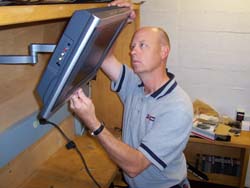Don't Mess With Texas

- LUBBOCK, TX-Media Support Group has made its name transforming schools and their stadiums into modern video production suites. From massive video boards to small TV stations, the company has integrated video into school districts with an emphasis on education. The accomplishment started with Greg Pare's interest in another facet of video production and culminated in his heading up the Media Support Group.
Operations manager David Benson, of Media Support Group, hangs an LCD monitor as part of the University of Houston's new football control room. The Cougars recently updated the video board in their football stadium.
Greg Pare moved to Lubbock, TX in 1985, to become a sports anchor. After four years of working for the local NBC affiliate, he left TV and went to work for the Lubbock independent school district. The district was installing a TV station, and Pare decided to assist them with the studio. He became operations manager of the station and assisted in building several more facilities in other districts.
Then Pare heard that a minor league hockey team was moving to Lubbock, and there were plans to install a video board in the local coliseum. "I called and asked who is installing and running the equipment," said Pare. "And they said, 'I guess you are,' which was great because with my TV studio experience, it was basically the same equipment."
Some of Media Support Group's first installs were small video installations in classrooms to help deliver morning announcements with visuals in addition to audio. But schools began demanding more elaborate studios as technology became more affordable.
At the Lubbock school district in Texas, Pare and Alice French, the innovator of the TV production program in the district, worked together to make the district a national leader in video for the education market, earning awards and national recognition. The spotlight caused schools from all over the country to begin calling Pare and French. After working part-time installing video in other schools, they decided to go full-time in 1992 and left Lubbock schools in 1994, starting their company, Media Support Group, with Pare as president.
In the mid '90s, the company transitioned into sports facilities when LED displays became more affordable. The problem they encountered was that the LED manufacturers were willing to sell the boards but not willing to build a control room for their clients. Pare developed a solution for both parties by going in with or after the manufacturers and building the control rooms. "It's been a nice little niche because not many clients have the money to spend on the control room, and they just don't realize what they're getting into," said Pare. "They've just spent half a million dollars on a board, and they're like, 'We have to spend more on a camera, instant replay, and graphics?' So there's a really nice market for small- to medium-budget control rooms."
Pare began to do work in school stadiums around 2000 when LEDs began to hit smaller colleges. High schools have jumped on now that the prices are dropping. Oftentimes these schools are running the boards with no prior understanding of video and the possibilities attached. Pare saw the need for educating his clients, so he took the next step and offered training.
"We look at ourselves as educators, which is partially my background," said Pare. "We train them on what it takes to have a successful event from the video board standpoint. As far as what necessitates good programming, is it just a spinning logo or is there fan interaction and good animations and camera shots? The more you put into it, the more you get out."
Pare also associates his company's success with his employee's educations as well as his own. "I pride myself on keeping abreast of the latest technology from attending various equipment tradeshows. From my experience in running events I know what user-friendly equipment needs to be in the control room, so I'll select certain pieces of gear that I think work well in the sports environment, and that's what I recommend to clients."
A daily selection of the top stories for AV integrators, resellers and consultants. Sign up below.
Edirol
A piece of gear that Pare frequently uses is Edirol's PR-50, a digital content server that works well with video scoreboard installations. "Anytime you need a graphic to happen fast, like a home run, you can't stumble through a bunch of files to get the piece up. The touchscreen ease of use with the Edirol PR-50 is something that competitors don't offer. It stores about six hours of video clips and animations and is perfect for the budget-conscience people looking for control rooms."
The future is bright for Pare as he believes that the demand for high-quality equipment will continue to grow for B-level sports facilities as LED technology gets more affordable. "The business will be around for awhile. The LEDs will eventually make a transition to highway billboards. You'll see more on buildings, and digital signage will expand. There will always be a demand for equipment to provide content for digital signage."
